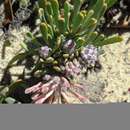en
names in breadcrumbs


Vexatorella is a genus containing four species of flowering plant, commonly known as vexators, in the family Proteaceae. The genus is endemic to the Cape Floristic Region of South Africa. The name means “little trouble-maker”, given with reference to the initial difficulties of placing V. latebrosa within the family. All species are shrubs which occur in dry fynbos habitats on the fringes of the Succulent Karoo ecoregion. The inflorescences are similar to those of the related leucospermums but also share features of the leucadendrons, with the floral bracts becoming woody and enlarged following pollination.[2] The flowers are insect-pollinated, with the seeds dispersed by ants (myrmecochory).[3]
Vexators are upright or spreading evergreen shrubs with alternately set, narrow, spade-shaped leaves ending bluntly in a bony tip, with an entire margin, and greyish or bluish in colour. The stalked flower heads are mostly set individually, sometimes with two to six together at the end of the stems, opening from the center outwards. The individual flowers are 4-merous, star symmetrical and hermaphrodite. The four perianth segments are pink or cream-coloured, and have a sweet smell. From their center, a straight style emerges that is hairless or powdery. The thickened part at its tip called pollen presenter is cleft at its tip. The ovary is egg- to bottle-shaped, consists of one carpel and contains just one cavity with one hanging primordial seed. The ovary is subtended by four free awl-shaped scales. The fruit is an egg-shaped hairless or powdery achene, that is beaked at its tip, and blunt and wrinkly at its base.[4] The bracteoles that support the individual flowers become woody after flowering, a character that set Vexatorella apart from Leucospermum except for L. secundifolium that also develops woody bracteoles.[5]
Comparison of homologous DNA has increased the insight in the phylogenetic relationships between the Proteaceae. Vexatorella belongs to a group that (except for Leucospermum saxosum) further only consists of genera endemic to the Cape Floristic Region, that together constitute the subtribe Leucadendrinae. Vexatorella is the closest relative of Paranomus. The genera Sorocephalus and Spatalla are the sister group to the Vexatorella and Paranomus. The following trees together represent those insights.[6]
subtribe LeucadendrinaeMimetes, Diastella and Orothamnus
Vexatorella
The described subtaxa are:[7][3]
Of the four species and two subspecies, the continued survival of three taxa, Vexatorella amoena and of V. obtusata both subsp. albomontana and obtusata, is considered to be of least concern. V. alpina is thought to be a near-threatened species. Vexatorella latebrosa on the other hand regarded as being critically endangered.[8]
Vexatorella is a genus containing four species of flowering plant, commonly known as vexators, in the family Proteaceae. The genus is endemic to the Cape Floristic Region of South Africa. The name means “little trouble-maker”, given with reference to the initial difficulties of placing V. latebrosa within the family. All species are shrubs which occur in dry fynbos habitats on the fringes of the Succulent Karoo ecoregion. The inflorescences are similar to those of the related leucospermums but also share features of the leucadendrons, with the floral bracts becoming woody and enlarged following pollination. The flowers are insect-pollinated, with the seeds dispersed by ants (myrmecochory).
Vexatorella es un género de árboles perteneciente a la familia Proteaceae. Es endémica de Sudáfrica.[1]
Vexatorella fue descrito por Rourke y publicado en Genera Plantarum Florae Germanicae 50(3): 377. 1984.[2] La especie tipo es: Vexatorella alpina (Salisb. ex Knight) Rourke.
Vexatorella es un género de árboles perteneciente a la familia Proteaceae. Es endémica de Sudáfrica.
Vexatorella é um género botânico pertencente à família Proteaceae.[1]
Vexatorella é um género botânico pertencente à família Proteaceae.
Vexatorella (лат.) — род цветковых растений семейства Протейные, в который входят кустарники, произрастающие в сухом финбоше на окраинах экологического региона Суккулентный Кару. Всего в роде насчитывается 4 вида. Эндемики Капской области Южной Африки. Соцветия похожи на соцветия родственных лейкоспермумов, но также имеют общие черты левкадендронов, при этом околоцветники становятся древесными и увеличиваются после опыления[3]. Цветы опыляются насекомыми, семена рассеиваются муравьями[4].
Виды Vexatorella представляют собой вертикальные или раскидистые вечнозеленые кустарники с очерёдными узкими лопатообразными листьями с твёрдым кончиком, края листа сероватого или голубоватого цвета. Стеблевые цветочные головки, как правило, отдельные, но могут расти в группе от двух до шести на конце стебля. Отдельные цветки четырёхлепестковые звёздообразные. Четыре сегмента околоцветника розового или кремового цвета и имеют сладковатый запах. Из центра цветка растёт прямой столбик пестика, безволосый или пудровый. Рыльце на кончике пестика расщеплено на кончике. Завязь имеет форму яйца или бутылки, содержит единственную полость с одной семяпочкой. Завязь представлена четырьмя свободными шиловидными чешуйками. Плод представляет собой яйцевидную безволосую или покрытое порошком семя с крючком на конце и тупое и морщинистое у основания. Чашелистники, которые поддерживают отдельные цветы, после цветения приобретают деревянистый характер.
Сравнение гомологичной ДНК показало, что род Vexatorella принадлежит к группе (кроме Leucospermum saxosum), в которую входят искключительно эндемичные для Капской области роды, которые вместе составляют подтрибу Leucadendrinae. Vexatorella наиболее близка к роду Paranomus. Sorocephalus и Spatalla является сестринской группой для Vexatorella и Paranomus. Родственные взаимоотношения между группами показаны ниже[5]:
подтриба LeucadendrinaeMimetes, Diastella, Orothamnus
Vexatorella
Следующие виды относят к роду Vexatorella[6][4]:
Vexatorella obtusata подвид albomontana
Vexatorella (лат.) — род цветковых растений семейства Протейные, в который входят кустарники, произрастающие в сухом финбоше на окраинах экологического региона Суккулентный Кару. Всего в роде насчитывается 4 вида. Эндемики Капской области Южной Африки. Соцветия похожи на соцветия родственных лейкоспермумов, но также имеют общие черты левкадендронов, при этом околоцветники становятся древесными и увеличиваются после опыления. Цветы опыляются насекомыми, семена рассеиваются муравьями.